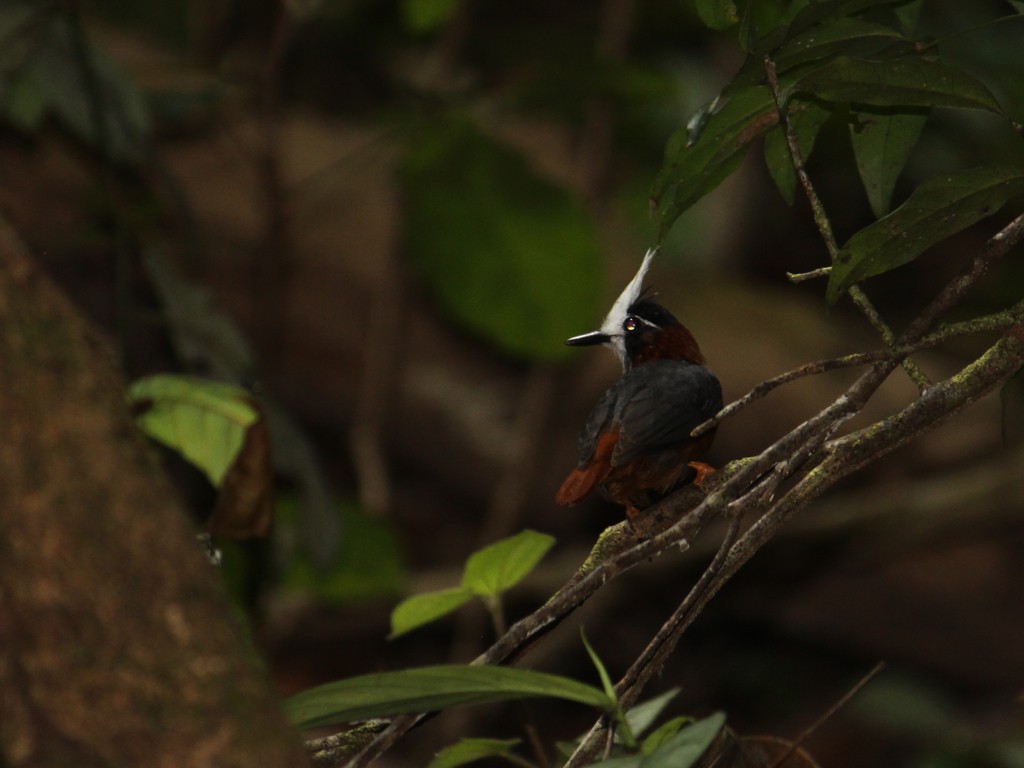White-plumed Antbird
A species of White-faced Antbirds Scientific name : Pithys albifrons Genus : White-faced Antbirds
White-plumed Antbird, A species of White-faced Antbirds
Botanical name: Pithys albifrons
Genus: White-faced Antbirds
Content
Description General Info
 Photo By matthieu_gauvain , used under CC-BY-NC-4.0 /Cropped and compressed from original
Photo By matthieu_gauvain , used under CC-BY-NC-4.0 /Cropped and compressed from original Description
The white-plumed antbird is monomorphic, meaning both sexes look the same. Adults have extensive rufous-chestnut plumage on their body, with contrasting black wings and head, and their signature white throats and feathered periocular tufts. Their feet and tarsus are bright orange. White-plumed antbirds have an average total body length of 13 cm, 4.6 cm of which is tail. Their bill is 1.16 cm long and only 0.47 cm wide on avarega, indicative of its insect food source. Young birds will have rufous coloured tips on their secondaries and a grayish head, without the white plumes or rufous collar. 
Size
13 cm
Nest Placement
Cavity
Feeding Habits
White-plumed Antbird forages on insects and arthropods, occasionally consuming lizards, exploiting army ant raids to access prey. Unique in its specialized feeding strategy alongside moving ant swarms.
Habitat
White-plumed Antbird primarily inhabits tropical moist lowland rainforests, including humid lowland and foothill evergreen forests up to 2,250 meters. It favors regions with dense canopy coverage, complex vegetation, and high plant diversity, spanning from the Guianas to the Andes. Preferring areas with a prevalence of army ants, it avoids open habitats and does not cross rivers, with optimal territories averaging 200 ha.
Dite type
Frugivorous
General Info
Feeding Habits
Bird food type

Fruit
Behavior
White-plumed antbirds are very persistent in holding on to territories and may remain even in case of conflict with other individuals, if enough food sources are available. They are generally solitary outside of the breeding season and will tend to follow individual ant swarms through the forest. Like other antbirds, they perform anting, which is the process of brushing small insects through their wing and tail feathers. It is still unknown whether the main function of this process is to ease irritation during moulting, kill mites, or detoxify distasteful insects. 
Distribution Area
The species is found in Brazil, Colombia, Venezuela, Ecuador and Peru; also the Guianas: Guyana, Suriname, and French Guiana. Its natural habitat is tropical moist lowland rainforests. The white-plummed antbird appears in higher abundances in forests with high canopies, high vegetation complexity and many plant species In the Amazon Basin proper, except in the headwaters of central Peru, the white-plumed antbird is found only north of the Amazon River, in the northeast (Guianas) and in the northwest, from Amapa and Cayenne westward to the Andes from southern Venezuela to northern Peru. They have been found at elevations of up to 2,250 m (7,380 ft) elevation (Mt. Duida, Venezuela) and 1,800 m (5,900 ft) (Cordillera Cutucu, Ecuador). They show higher survival in the eastern Amazon rainforest than in the western. Each individual occupies a home range exceeding 200 ha (490 acres) in order to ensure that swarms of army ants to follow to food can be found at all times. They will avoid open habitats and will not cross rivers. They have, however, been found crossing roads to get from one patch of forest to another. 
Species Status
Not globally threatened.
Scientific Classification
Phylum
Chordates Class
Birds Order
Perching birds Family
Antbirds Genus
White-faced Antbirds Species
White-plumed Antbird